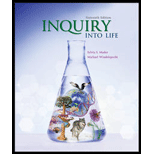
To analyze:
The reason the organisms must acquire materials and energy.
Introduction:
All matter in the biosphere can be divided into two groups namely, living and non-living things. Living things are made up of cells while non-living things are made up of atoms. Living things have some basic characteristics namely growth, survival, and reproduction by which they can be differentiated from non-living things.
Explanation of Solution
Living things (a biotic component of the ecosystem) may be broadly divided into two groups namely, autotrophs and heterotrophs. Green plants and some microbes are autotrophs as they can synthesize their own food in the form of sugar, as starch. The other organisms which depend on autotrophs for food are known as heterotrophs.
Both groups of living organisms need the energy to perform vital functions for survival. The autotroph uses the solar energy to synthesize its food. The energy can be transferred from one trophic level to the next by the process of energy flow as the heterotrophs consume the other organisms.
The food molecules are broken down by the process of digestion to liberate energy. This energy can be utilized for the physiological activities of the organism as well as the construction of essential
Organisms must acquire materials and energy for survival.
Want to see more full solutions like this?
Chapter 2 Solutions
Inquiry Into Life (16th Edition)
- Using quail and chick embryos, quail-specific antibody and fluorescent tissue-specific antibodies, design an experiment where you investigate the tissues the cranial neural crest can give rise to. What are four derivatives of the cranial neural crest that you expect to see in the resulting chimeric embryos?arrow_forwardDoes the neural crest have to undergo epithelial to mesenchymal transition prior to migration through the developing embryo? Does the neural crest differentiate into different cell types based on their axial position along the anterior and posterior axis?arrow_forwardUsing quail and chicken embryos, what kind of experiment would you conduct to test if rib forming somites have their axial identity specified before segmentation? How do we know this phenotype is due to axial identity being specified before segmentation and not due to our experimental method?arrow_forward
- 8. Aerobic respiration of a 5 mM solution of tripeptide that is composed of the following three amino acids; alanine, leucine and isoleucine. Alanine breaks down to pyruvate, leucine breaks down to Acetyl-CoA and isoleucine breaks down to succinyl-CoA. Alanine NADH FADH2 OP ATP SLP ATP Total ATP Leucine Isoleucine Totals Show your work using dimensional analysis here: 4arrow_forward9. Aerobic respiration of one lipid molecule. The lipid is composed of one glycerol molecule connected to two fatty acid tails. One fatty acid is 12 carbons long and the other fatty acid is 18 carbons long in the figure below. Use the information below to determine how much ATP will be produced from the glycerol part of the lipid. Then, in part B, determine how much ATP is produced from the 2 fatty acids of the lipid. Finally put the NADH and ATP yields together from the glycerol and fatty acids (part A and B) to determine your total number of ATP produced per lipid. Assume no other carbon source is available. fatty acids glycerol 18 carbons 12 carbons 0=arrow_forwardinfluences of environment on the phenotype.arrow_forward
- What is the difference between codominance and phenotypic plasticity?arrow_forwardExplain the differences between polygeny and pleiotropy,arrow_forwardIf using animals in medical experiments could save human lives, is it ethical to do so? In your answer, apply at least one ethical theory in support of your position.arrow_forward
- You aim to test the hypothesis that the Tbx4 and Tbx5 genes inhibit each other's expression during limb development. With access to chicken embryos and viruses capable of overexpressing Tbx4 and Tbx5, describe an experiment to investigate whether these genes suppress each other's expression in the limb buds. What results would you expect if they do repress each other? What results would you expect if they do not repress each other?arrow_forwardYou decide to delete Fgf4 and Fgf8 specifically in the limb bud. Explain why you would not knock out these genes in the entire embryo instead.arrow_forwardYou implant an FGF10-coated bead into the anterior flank of a chicken embryo, directly below the level of the wing bud. What is the phenotype of the resulting ectopic limb? Briefly describe the expected expression domains of 1) Shh, 2) Tbx4, and 3) Tbx5 in the resulting ectopic limb bud.arrow_forward
 Human Anatomy & Physiology (11th Edition)BiologyISBN:9780134580999Author:Elaine N. Marieb, Katja N. HoehnPublisher:PEARSON
Human Anatomy & Physiology (11th Edition)BiologyISBN:9780134580999Author:Elaine N. Marieb, Katja N. HoehnPublisher:PEARSON Biology 2eBiologyISBN:9781947172517Author:Matthew Douglas, Jung Choi, Mary Ann ClarkPublisher:OpenStax
Biology 2eBiologyISBN:9781947172517Author:Matthew Douglas, Jung Choi, Mary Ann ClarkPublisher:OpenStax Anatomy & PhysiologyBiologyISBN:9781259398629Author:McKinley, Michael P., O'loughlin, Valerie Dean, Bidle, Theresa StouterPublisher:Mcgraw Hill Education,
Anatomy & PhysiologyBiologyISBN:9781259398629Author:McKinley, Michael P., O'loughlin, Valerie Dean, Bidle, Theresa StouterPublisher:Mcgraw Hill Education, Molecular Biology of the Cell (Sixth Edition)BiologyISBN:9780815344322Author:Bruce Alberts, Alexander D. Johnson, Julian Lewis, David Morgan, Martin Raff, Keith Roberts, Peter WalterPublisher:W. W. Norton & Company
Molecular Biology of the Cell (Sixth Edition)BiologyISBN:9780815344322Author:Bruce Alberts, Alexander D. Johnson, Julian Lewis, David Morgan, Martin Raff, Keith Roberts, Peter WalterPublisher:W. W. Norton & Company Laboratory Manual For Human Anatomy & PhysiologyBiologyISBN:9781260159363Author:Martin, Terry R., Prentice-craver, CynthiaPublisher:McGraw-Hill Publishing Co.
Laboratory Manual For Human Anatomy & PhysiologyBiologyISBN:9781260159363Author:Martin, Terry R., Prentice-craver, CynthiaPublisher:McGraw-Hill Publishing Co. Inquiry Into Life (16th Edition)BiologyISBN:9781260231700Author:Sylvia S. Mader, Michael WindelspechtPublisher:McGraw Hill Education
Inquiry Into Life (16th Edition)BiologyISBN:9781260231700Author:Sylvia S. Mader, Michael WindelspechtPublisher:McGraw Hill Education





